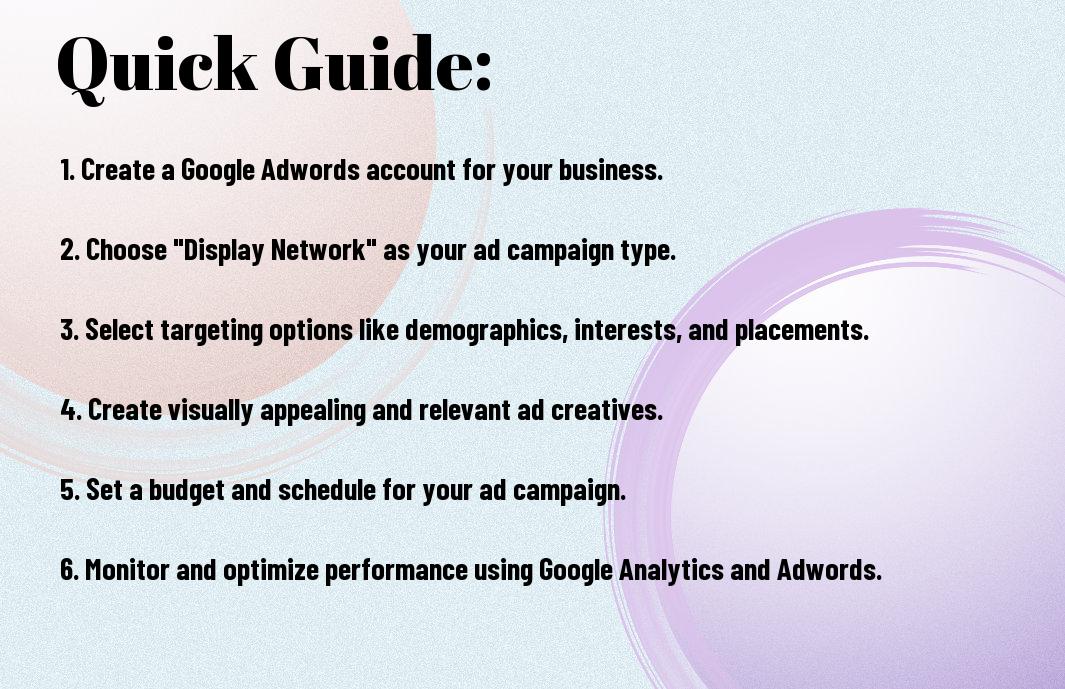Elevate your digital marketing game with . The Google Display Network (GDN) is a powerhouse of potential for reaching potential customers and expanding your brand’s visibility. By harnessing the power of GDN ads, you can showcase your products and services across a vast network of websites, making it an essential tool for any business looking to boost their online presence. In this guide, we’ll cover everything from the basics of GDN ads to best practices for creating effective and engaging display ads.
When it comes to digital advertising, the Google Display Network is not to be underestimated. With the ability to reach over 90% of internet users worldwide, GDN ads offer an unparalleled opportunity to connect with your target audience. However, with great power comes great responsibility, and it’s crucial to approach GDN ads with a strategic and informed mindset. Whether you’re new to the world of display advertising or looking to enhance your current GDN ad strategy, this guide will provide you with the knowledge and tools you need to make the most of this powerful marketing tool. For even more in-depth insights, you can also refer to Google’s own Display ads: a creative Best Practices guide for expert tips and advice.

Types of Google Display Network Ads
Assuming you want to reach your target audience on the Google Display Network, it’s essential to understand the different types of ads available to you. Knowing the unique features of each ad type will help you create a more effective and engaging advertising strategy. Below is a breakdown of the various types of Google Display Network ads:
| Ad Type | Description |
|---|---|
| Text Ads | Simple, clickable text-based ads that appear on websites within the Google Display Network. |
| Image Ads | Visually appealing static image ads that can be displayed on relevant websites within the network. |
| Rich Media Ads | Interactive, multimedia ads that can include elements such as video, audio, and animation. |
| Video Ads | Engaging video content displayed on websites and apps across the Google Display Network. |
| Responsive Ads | Dynamic ads that automatically adjust their size, appearance, and format to fit available ad spaces. |
Text Ads and Their Unique Features
When it comes to text ads, the simplicity and directness of the message are its strengths. They are great for driving clicks and conversions, especially when paired with compelling ad copy that resonates with your audience. Text ads provide a straightforward approach to delivering your message and can be a cost-effective option for reaching potential customers on the Google Display Network.
Image Ads and Engaging Visuals
For businesses looking to capture attention visually, image ads are a powerful tool. These ads allow you to convey your brand’s message and create a strong visual impact on your target audience. With the right visuals and design, image ads can be highly effective in driving brand awareness and increasing engagement.
Rich Media Ads with Interactive Elements
Rich media ads offer a dynamic way to engage with your audience through various interactive elements such as video, audio, and animation. These ads provide a more immersive experience for users, making them more likely to interact with your content. With the ability to incorporate multiple media formats, rich media ads can boost engagement and conversion rates.
Video Ads for Dynamic Content Engagement
Video ads provide a compelling way to deliver dynamic content and capture the attention of your audience. Whether it’s a product demonstration, a brand story, or a promotional video, video ads can engage and persuade viewers in a way that other ad formats can’t. They are particularly effective for showcasing products or services in action and increasing brand recognition.
Responsive Ads for Flexibility across Devices
With responsive ads, you can ensure that your ads look great on any device, whether it’s a desktop, tablet, or mobile phone. These ads adapt to the available ad space, ensuring that your message remains consistent across different screen sizes. Responsive ads provide flexibility and convenience for advertisers looking to reach audiences across various devices.
Crafting Your GDN Strategy: A Step-by-Step Guide
To ensure the success of your Google Display Network (GDN) ads, you need to carefully craft a strategic plan that aligns with your business goals and target audience. Below is a step-by-step guide to help you formulate your GDN strategy effectively.
Setting Clear Advertising Objectives
When it comes to creating a successful GDN campaign, it all starts with setting clear advertising objectives. This step is crucial as it lays the foundation for the entire strategy. Make sure your objectives are specific, measurable, achievable, relevant, and time-bound (SMART). Identify what you want to accomplish with your ads – whether it’s increasing brand awareness, driving website traffic, or generating leads and sales. By establishing clear objectives, you will be better equipped to measure the success of your GDN campaign.
Identifying Your Target Audience
In order to maximize the effectiveness of your GDN ads, you must clearly identify your target audience. Understand the demographics, interests, and behaviors of your ideal customers. This will enable you to tailor your ad messaging to resonate with your audience and increase the likelihood of engagement and conversions. Utilize audience insights and research to develop a deep understanding of who your ads should be reaching.
Choosing the Right Types of Ads for Your Campaign
When it comes to selecting the right types of ads for your GDN campaign, it’s essential to consider the different formats available and choose the ones that align with your advertising objectives and target audience. Display ads, responsive ads, and video ads are some of the options you can choose from. Consider the visual appeal and interactivity of each ad format and select the ones that will best capture the attention of your audience. Additionally, leveraging remarketing ads can help you re-engage with users who have previously interacted with your website or app, increasing the chances of conversion. The table below outlines the types of ads you can consider for your GDN campaign:
| Ad Type | Description |
| Display Ads | Traditional image or text-based ads that appear on websites within the GDN. |
| Responsive Ads | Automatically adjust their size, appearance, and format to fit available ad spaces on the GDN. |
| Video Ads | Engaging ad format that delivers your message through sight, sound, and motion. |
| Remarketing Ads | Target users who have previously visited your website or app with tailored ads. |
The key is to select ad types that will effectively capture the attention of your target audience and drive desired actions.
Step-by-Step Ad Creation Process
Once you have a clear understanding of your advertising objectives, target audience, and chosen ad types, you can begin the ad creation process. This involves developing compelling ad copy, captivating visuals, and persuasive calls-to-action that align with your campaign goals. It’s important to test different variations of your ads to determine which ones perform the best. The table below outlines the step-by-step ad creation process:
| Step | Description |
| Define messaging and visuals | Develop ad copy and select imagery or video content that effectively communicates your message. |
| Create multiple ad variations | Generate different versions of your ads to test and optimize for performance. |
| Implement calls-to-action | Include clear and compelling calls-to-action that prompt users to take the desired action. |
| Set up ad rotation | Configure ad rotation settings to evenly show your different ad variations for testing. |
By following a structured ad creation process, you can ensure that your GDN ads are compelling, engaging, and aligned with your campaign objectives.
Implementing Conversion Tracking
Implementing conversion tracking is essential for measuring the success of your GDN campaign. By tracking actions that are valuable to your business, such as form submissions, purchases, or sign-ups, you can gain valuable insights into the effectiveness of your ads and website. Conversion tracking allows you to optimize your campaign for the actions that matter most and make data-driven decisions to improve your advertising strategy.
Key Factors That Affect GDN Ad Success
Unlike other forms of online advertising, Google Display Network (GDN) ads depend on several factors for their success. Understanding these key factors can help you optimize your GDN ad campaigns and achieve better results. Here are some of the crucial elements that affect the success of your GDN ads:
- Quality Score: The relevance and quality of your ad content and landing page.
- Bid Strategies: The amount you’re willing to pay for ad placement and the bidding strategy you employ.
- Targeting Options: The methods you use to reach your audience, such as contextual, behavioral, and remarketing targeting.
- Ad Placement: Selecting the right websites and apps for your ad placement.
- Budget Allocation: How you allocate your budget and its impact on ad performance.
After understanding the significance of these factors, you can make informed decisions to improve the performance of your GDN ads.
Quality Score: What It Is and How to Improve It
The Quality Score of your GDN ads is a crucial factor in determining their effectiveness. It’s a measure of the relevance and quality of your ad content and landing page in relation to the user’s search query or the content of the website they’re visiting. A higher Quality Score can lead to lower costs and better ad placement. To improve your Quality Score, focus on creating relevant, engaging ad content and ensuring that your landing page provides a high-quality user experience.
Bid Strategies: From Manual to Automated Bidding
When it comes to bidding on GDN, you have the option of manually setting your bids or using automated bidding strategies. Manual bidding gives you more control over your bids, while automated bidding can help optimize your bids based on your goals. You can choose from different bidding strategies such as target CPA, target ROAS, and maximize clicks to ensure that your ad spending is aligned with your objectives.
Targeting Options: Contextual, Behavioral, and Remarketing
Targeting the right audience is essential for GDN ad success. Contextual targeting allows you to display your ads on websites that are relevant to your keywords. Behavioral targeting enables you to reach users based on their browsing behavior, while remarketing helps you reconnect with users who have previously visited your website. By leveraging these targeting options effectively, you can increase the relevance of your ads and improve their performance.
Ad Placement: Choosing the Right Websites and Apps
The placement of your GDN ads plays a significant role in their performance. You can choose specific websites, pages, or apps where you want your ads to appear, or opt for automatic placements based on your targeting settings. By carefully selecting the right placements, you can ensure that your ads are displayed in relevant contexts and to the right audience.
Budget Allocation and Its Impact on Ad Performance
Your budget allocation can impact the performance of your GDN ads. By strategically allocating your budget across campaigns and targeting options, you can maximize the effectiveness of your ad spend. Monitoring and adjusting your budget allocation based on the performance of your ads can help you achieve better results.
Tips for Optimizing Your GDN Ads
Your Google Display Network (GDN) ads can be a powerful tool for reaching potential customers and driving business growth. Here are some essential tips to help you optimize your GDN ads and maximize their effectiveness:
- Ensure your ads contain relevant keywords that are closely related to your business and target audience.
- Use compelling call-to-action phrases to encourage clicks and conversions.
- Regularly monitor and tweak your ad performance to improve ROI.
Thou, to learn more about how to increase your reach with display ad campaigns, check out Increase Your Reach with Display Ad Campaigns.
Design Tips for Attention-Grabbing Ads
When creating GDN ads, it’s crucial to design them in a way that attracts the viewer’s attention and effectively communicates your message. Use high-quality images and clear, concise branding to create visually appealing ads. Additionally, consider employing animation and interactive elements to make your ads more engaging and memorable. Thou, the visual aspects of your ads play a significant role in capturing the audience’s interest and driving action.
Copywriting Tips for Effective Messaging
Compelling ad copy is essential for conveying your brand’s message and persuading viewers to take action. Ensure that your copy is concise and enticing, highlighting the key benefits of your products or services. Assume that your audience has a limited attention span, so make every word count. Use action-oriented language to encourage immediate response and clearly communicate the value of engaging with your ad.
A/B Testing: Methods and Best Practices
A/B testing is a valuable strategy for determining which ad elements resonate most effectively with your target audience. When conducting A/B tests, focus on one variable at a time, such as the headline, imagery, or call-to-action. Analyze the results to uncover insights that can guide future ad optimizations. By consistently testing and refining your ads, you can improve their performance and drive better results.
Tips for Enhancing Ad Relevance and CTR
To enhance the relevance of your GDN ads, consider creating customized ad content tailored to different audience segments. Use remarketing to re-engage users who have previously interacted with your brand. Additionally, employ targeted keywords and placement targeting to ensure that your ads appear in relevant contexts. Thou, leveraging these tactics can increase ad relevance and improve click-through rates.
Use of Analytics for Continuous Improvement
Utilizing analytics is critical for ongoing optimization of your GDN ads. By analyzing engagement metrics and conversion data, you can gain valuable insights into the effectiveness of your ads and make informed decisions about future optimizations. Furthermore, make use of A/B testing and multivariate testing to continually refine your ad campaigns and maximize their impact.
Analyzing the Pros and Cons of GDN Advertising
Not all advertising methods are created equal, and the Google Display Network (GDN) is no exception. While GDN offers a range of benefits, it also comes with its own set of challenges. Here, we’ll take a closer look at the pros and cons of GDN advertising to help you make an informed decision about whether it’s the right choice for your business.
| Pros | Cons |
| Wide Reach | Potentially Lower Intent |
| Targeting Options | Ad Blindness |
| Visibility |
Pros: Wide Reach, Targeting, and Visibility
When it comes to GDN advertising, one of the standout advantages is its wide reach. With millions of websites, apps, and videos included in the network, your ads have the potential to reach a vast audience. Additionally, GDN offers a variety of targeting options, allowing you to narrow down your audience based on demographics, interests, and online behaviors. This level of targeting can help you connect with the right people at the right time. Furthermore, the visibility of GDN ads can increase brand awareness and recognition, even if users don’t immediately click on your ad.
Cons: Potentially Lower Intent and Ad Blindness
While GDN can help your ads reach a large audience, some drawbacks need to be considered. One potential concern is the lower intent of users who come across your ads. Unlike search ads, which target users actively searching for related keywords, GDN ads may be shown to users who are not actively seeking your product or service, resulting in lower conversion rates. Additionally, ad blindness is a common issue on the Display Network, as users may become accustomed to seeing ads and start to ignore them, impacting the effectiveness of your campaign.
ROI Considerations: Balancing Costs and Gains
When evaluating GDN advertising, it’s important to consider the return on investment (ROI). While GDN offers a wide reach and branding opportunities, it’s crucial to balance the costs with the potential gains. Carefully analyze the performance of your GDN campaigns to ensure they are delivering the desired results. Keep an eye on metrics such as click-through rates, conversion rates, and overall campaign costs to assess the true impact on your bottom line.
When to Use GDN Ads in Your Overall Marketing Mix
Understanding when to incorporate GDN ads into your overall marketing strategy is essential. While GDN can be effective for raising brand awareness and reaching a broad audience, it may not be the best choice for driving immediate conversions. Consider using GDN to complement other advertising efforts and support your brand’s visibility across the web. It can be particularly useful for engaging potential customers who are at the awareness or consideration stage of the buying journey.

Case Studies and Success Stories
Now let’s take a look at some case studies and success stories to see how businesses like yours have effectively utilized the Google Display Network (GDN) to reach their target audience and drive results.
- XYZ Company: Increased their website traffic by 60% and saw a 35% boost in conversions after running GDN ads targeting specific demographic segments.
- ABC Restaurant: Generated a 40% increase in reservations by using GDN to promote their special events and offering targeted ads to local food enthusiasts.
- Jane’s Boutique: Achieved a 25% lift in online sales by showcasing their latest collection through visually appealing banner ads on GDN.
Small Business Successes on the GDN
Small businesses have also found great success on the Google Display Network. Many have been able to effectively target their local audience and drive actionable results. Whether you are a local service provider or a retail outlet, GDN offers a powerful platform to reach potential customers in your area and beyond.
Case Study: Effective Use of Rich Media Ads
Rich media ads can be a game-changer for businesses looking to capture the attention of their audience with visually appealing and interactive content. By incorporating rich media ads into their GDN campaigns, businesses have experienced higher engagement rates and increased brand recall. You too can leverage the power of rich media ads to stand out and make a lasting impression on your target audience.
International Campaigns: Insights and Outcomes
Expanding your business to international markets? The Google Display Network provides valuable insights and outcomes for businesses looking to reach a global audience. With targeting options that allow you to connect with specific regions and demographics, businesses have been able to successfully expand their reach across borders and drive international growth. You can gain valuable insights and achieve measurable outcomes by running international campaigns on the GDN.

Common Mistakes to Avoid with GDN Ads
Despite the potential of Google Display Network (GDN) ads to greatly benefit your business, there are common mistakes that many marketers make when running their ad campaigns. These mistakes can lead to wasted budget, ineffective targeting, and poor ad performance. Avoiding these missteps is crucial to achieving success with GDN ads.
Budget Mismanagement
One of the most common mistakes when running GDN ad campaigns is mismanaging your budget. It’s essential to set a realistic budget based on your advertising goals and closely monitor your spending to ensure that you’re getting the best return on investment. Some marketers make the mistake of either setting an unrealistic low budget that limits the reach and effectiveness of their ads, or overshooting their budget and quickly burning through funds without seeing the desired results. It’s important to strike the right balance and continuously optimize your budget allocation to maximize your ad performance.
Furthermore, not allocating your budget effectively across different targeting options and ad formats can also lead to poor results. You need to carefully assess which targeting options and ad types are bringing in the best results and adjust your budget accordingly. Without proper budget management, you run the risk of overspending on underperforming ads and missing out on more promising opportunities.
Poor Targeting Decisions
Another common mistake with GDN ads is making poor targeting decisions. Without properly defining your target audience, you may end up displaying your ads to the wrong people, leading to wasted impressions and a low conversion rate. Ensuring that you have a clear understanding of your ideal customer and using advanced targeting options such as demographic targeting, remarketing, and custom affinity audiences can significantly improve the effectiveness of your GDN ads.
Additionally, not optimizing your targeting options based on the performance data can also lead to poor results. It’s crucial to regularly analyze the performance of your ads and adjust your targeting settings to ensure that your ads are reaching the right audience.
Overlooking Ad Design Principles
Effective ad design is paramount in capturing the attention of your target audience and driving engagement. Ignoring ad design principles such as compelling imagery, concise copy, and a clear call-to-action can result in underwhelming ad performance. In the crowded space of the GDN, it’s essential to create visually appealing and persuasive ads that stand out amidst the competition. Neglecting to invest time and resources into creating high-quality ad creatives can limit the success of your GDN campaigns.
Neglecting Data and Performance Analysis
Another critical mistake is neglecting data and performance analysis. Without regularly analyzing the data from your GDN ads, you may miss out on valuable insights that could inform and optimize your campaigns. By closely monitoring key performance indicators such as click-through rate, conversion rate, and cost per acquisition, you can identify areas for improvement and make data-driven decisions to enhance the effectiveness of your ads.
Additionally, not utilizing tools such as Google Analytics to track and measure the performance of your GDN ads can hinder your ability to gauge the success of your campaigns. It’s important to regularly review the performance data and make informed adjustments to maximize the impact of your GDN ads.
By avoiding these common mistakes with your GDN ads, you’ll be better positioned to drive meaningful results and effectively promote your business to your target audience.
Advanced Techniques and Considerations
After you have mastered the basics of Google Display Network (GDN) advertising, it’s time to explore some advanced techniques and factors to consider when creating and optimizing your ads. Here are some crucial considerations to keep in mind as you continue to refine your GDN strategy:
- Advanced targeting options: As you become more familiar with GDN, consider using advanced targeting options such as custom intent audiences, affinity audiences, and in-market audiences to reach your ideal customers more effectively.
- Ad creative and placement optimization: Continuously test and optimize your ad creatives and placements to improve performance and ensure that your ads are being shown to the right audience at the right time.
- Conversion tracking and attribution: Implement robust conversion tracking and attribution models to accurately measure the impact of your GDN campaigns on your business goals.
Leveraging AI and Machine Learning in GDN
As you delve deeper into GDN advertising, you can leverage the power of artificial intelligence (AI) and machine learning to optimize your campaigns. Machine learning algorithms can analyze vast amounts of data to identify patterns and trends, allowing you to make data-driven decisions to maximize the performance of your GDN ads. By utilizing AI and machine learning technologies, you can automate various aspects of your GDN campaigns, such as bidding and targeting, to achieve better results and more efficient campaign management.
Incorporating GDN into Your Multi-Channel Approach
Integrating GDN into your multi-channel marketing approach can lead to a more cohesive and effective overall marketing strategy. By combining GDN with other channels such as search, social, and video advertising, you can create a seamless brand experience for your audience and reach them at various touchpoints throughout their customer journey. This holistic approach allows you to maximize the impact of your marketing efforts and drive consistent results across different platforms.
Legal and Compliance Aspects of GDN Advertising
When running GDN ads, it is crucial to ensure that your campaigns comply with legal and regulatory requirements. This includes adhering to data protection laws, industry-specific regulations, and Google’s advertising policies. Failure to comply with these rules can result in penalties and damage to your brand’s reputation. Therefore, it’s essential to stay informed about the legal and compliance aspects of GDN advertising and to regularly review and update your campaigns to remain compliant with any changes in regulations.
Future Trends and Innovations in Display Advertising
As you continue to refine your GDN strategy, it’s important to stay abreast of the latest trends and innovations in display advertising. From the rise of interactive and dynamic ad formats to the increasing emphasis on personalized and contextually relevant ads, the landscape of display advertising is constantly evolving. By keeping an eye on emerging trends and innovations, you can position your business to take advantage of new opportunities and stay ahead of the competition in the dynamic world of GDN advertising.

Conclusion: Utilizing Google Display Network Ads for Your Business
Drawing together all the information we’ve covered, implementing Google Display Network Ads for your business can be a powerful tool for reaching your target audience and driving conversions. By leveraging the expansive reach and targeting capabilities of the GDN, you can effectively showcase your ads across a wide variety of websites, reaching potential customers at various stages of the buying cycle.
Ultimately, incorporating GDN Ads into your digital marketing strategy can help you increase brand awareness, drive website traffic, and ultimately, boost sales and conversions. With the ability to tailor your ads to specific demographics, interests, and behaviors, you can ensure that your messages are reaching the right audience at the right time. Additionally, the flexibility and customization options available through the GDN allow you to optimize your campaigns for maximum performance, ensuring that you are getting the most out of your ad spend. So, if you haven’t already, consider integrating GDN Ads into your marketing mix to enjoy the benefits of this powerful advertising platform.



